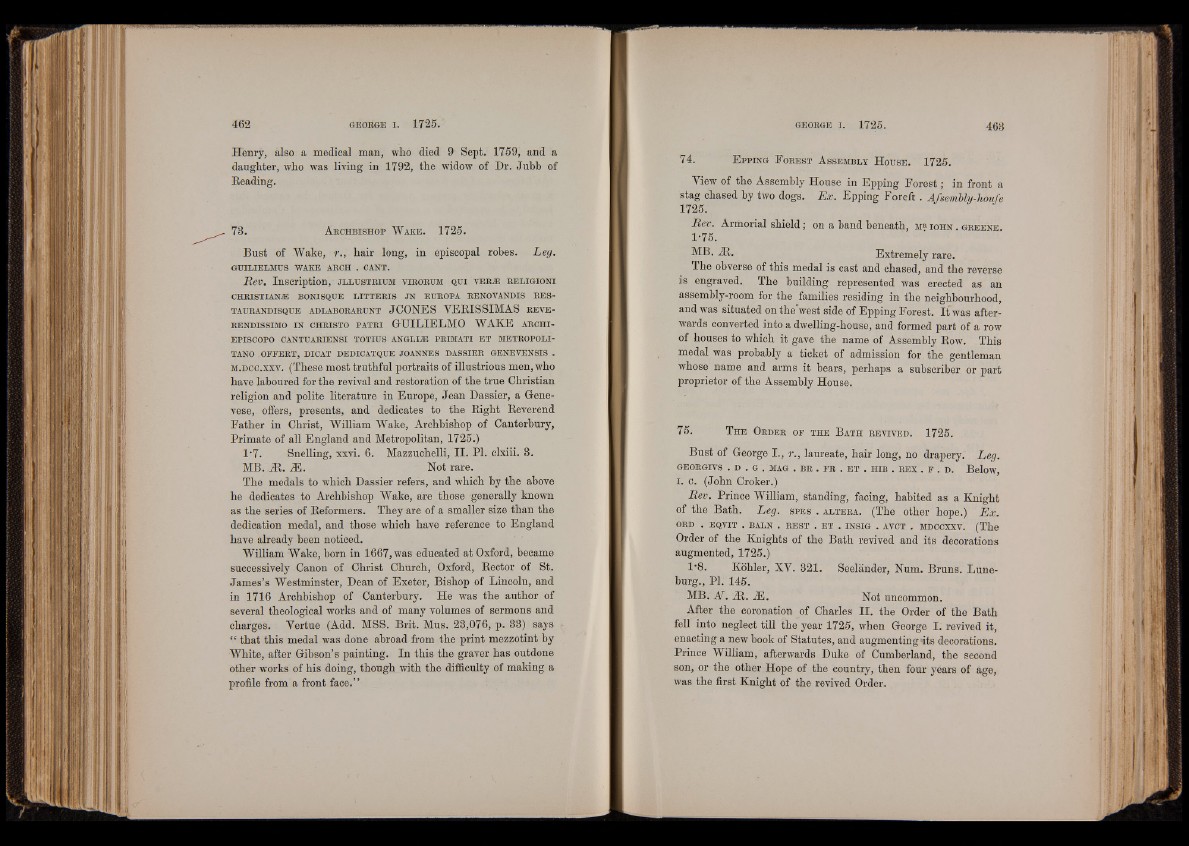
Henry, also a medical man, who died 9 Sept. 1759, and a
daughter, who was living in 1792, the widow of Dr. Jubb of
Reading.
73. A r c h b is h o p W a k e . 1725.
Bust of Wake, r., hair long, in episcopal robes. Leg.
GUILIELMUS WAKE ARCH . CANT.
Lev. Inscription, jl l t js t r iu m v ir o r um q u i v e r « r e l ig io n i
CHRISTIAN« BONISQUE LITTERIS JN EUROPA RENOVANDIS RES-
TAÜRANDISQUE ADLABORARUNT JCONES VERISSIMAS REVE-
RENDISSIMO IN CHRISTO PATRI GUILIELMO WAKE ARCHI-
EPISCOPO CANTUARIENSI TOTIUS ANGLI« PRIMATI ET METROPOLITANO
OFFERT, DICAT DEDICATQUE JOANNES DASSIER GENEVENSIS .
M.DCC.xxv. (These most truthful portraits of illustrious men, who
have laboured for the revival and restoration of the true Christian
religion and polite literature in Europe, Jean Dassier, a Genevese,
offers, presents, and dedicates to the Right Reverend
Father in Christ, William Wake, Archbishop of Canterbury,
Primate of all England and Metropolitan, 1725.)
P7. Snelling, xxvi. 6. Mazzuchelli, II. PI. clxiii. 3.
MB. iR. M . Not rare.
The medals to which Dassier refers, and which by the above
he dedicates to Archbishop Wake, are those generally known
as the series of Reformers. They are of a smaller size than the
dedication medal, and those which have reference to England
have already been noticed.
William Wake, bom in 1667, was educated at Oxford, became
successively Canon of Christ Church, Oxford, Rector of St.
James’s Westminster, Dean of Exeter, Bishop of Lincoln, and
in 1716 Archbishop of Canterbury. He was the author of
several theological works and of many volumes of sermons and
charges. Yertue (Add. MSS. Brit. Mus. 23,076, p. 33) says
“ that this medal was done abroad from the print mezzotint by
White, after Gibson’s painting. In this the graver has outdone
other works of his doing, though with the difficulty of making a
profile from a front face.”
74. E p p in g F o r e s t A s s em b l y H o u s e . 1725.
View of the Assembly House in Epping Forest; in front a
stag chased by two dogs. Ex. Epping Foreft. AJsembly-houfe
1725.
Lev. Armorial shield; on a band beneath, m» io h n . g r e e n e
1-75.
MB. JR. Extremely rare.
The obverse of this medal is cast and chased, and the reverse
is engraved. The building represented was erected as an
assembly-room for the families residing in the neighbourhood,
and was situated on the’west side of Epping Forest. It was afterwards
converted into a dwelling-house, and formed part of a row
of houses to which it gave the name of Assembly Row. This
medal was probably a ticket of admission for the gentleman
whose name and arms it bears, perhaps a subscriber or part
proprietor of the Assembly House.
75. T h e Or d e r o f t h e B a t h r e v iv e d . 1725.
Bust of George I., r., laureate, hair long, no drapery. Leg.
GEORGrVS . D . G . MAG . BR . FR . ET . HIB . REX . F . D. Below,
I . c. (John Croker.)
Lev. Prince William, standing, facing, habited as a Knight
of the Bath. Leg. s p e s . a l t e r a . (The other hope.) Ex.
ORD . EQVIT . BALN . REST . ET . INSIG . AVCT . MDCCXXV. (The
Order of the Knights of the Bath revived and its decorations
augmented, 1725.)
l -8. Köhler, XY. 321. Seeländer, Num. Bruns. Lune-
burg., PI. 145.
MB. N . 2R. M . x Not uncommon.
After the coronation of Charles II. the Order of the Bath
fell into neglect till the year 1725, when George I. revived it,
enacting a new book of Statutes, and augmenting "its decorations.
Prince William, afterwards Duke of Cumberland, the second
son, or the other Hope of the country, then four years of age,
was the first Knight of the revived Order.